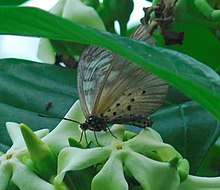Acraea pentapolis
Acraea pentapolis, also known as the scarce tree-top acraea or eastern musanga acraea, is a butterfly in the family Nymphalidae. It is found in western and central Africa.[2] The habitat consists of forests.
| Acraea pentapolis | |
|---|---|
 | |
| Scientific classification | |
| Kingdom: | Animalia |
| Phylum: | Arthropoda |
| Class: | Insecta |
| Order: | Lepidoptera |
| Family: | Nymphalidae |
| Genus: | Acraea |
| Species: | A. pentapolis |
| Binomial name | |
| Acraea pentapolis | |
| Synonyms | |
| |
The larvae feed on Myrianthus holstii.
Description
In 1912, Harry Eltringham wrote:
Male. Expanse 60–76 mm. Wings semitransparent, due to absence of scales. Forewing costa, apex, and hind margin powdered with brownish. Several ill-defined dusky marks varying much in intensity but usually consisting of the following. A broad irregular mark in cell over origin of 2, a blackish mark on discocellulars, a series of rudimentary marks beyond cell in the form of an oblique discal band of spots in 6, 5, 4, and 3, a mark at base of area 2 and beneath it running downwards and outwards a mark in lb. In the same area a short indistinct longitudinal streak at base. Hindwing with a dusky powdering round hind margin, and more or less evident darker internervular rays showing their greatest development in 2, 1c, and lb. Lower half of cell, base of 3, basal half of 2, and the greater part of 1c, lb, and la covered with scales which vary in colour from pale lemon-ochreous to brick red. In some cases this patch is very fully developed and of definite outline, whilst in others it is merely indicated. Numerous black spots corresponding to those on underside but varying much in size and number.
Underside. Forewing almost devoid of scales, hindwing as above but the yellow or red patch paler and less developed. Black spots very variable in number. In the case of maximum development the following may be observed. A spot in 9, a subbasal and a central (very small) in 7, one at extreme base of 5, and a double spot at base of 4, two in cell before middle, three or four discal spots progressively larger in size, in 6, 5, 4, and 3, a large spot at base of 2 followed by a spot in 1c and lb, these three nearly in a straight line, but that in 1c slightly nearer base. A basal and a subbasal in spot in 1c, ditto in lb, and a basal and two other spots in 1 a.
Head black with a few whitish dots and two tufts on collar,thorax black with whitish marks, abdomen black above with whitish segmental lines and lateral spots. Claws unequal.
Female like the male and presenting the same variations of pattern.[3]
Subspecies
- Acraea pentapolis pentapolis (Cameroon, Gabon, Angola, Democratic Republic of the Congo, Uganda, western Kenya)
- Acraea pentapolis epidica Oberthür, 1893 (Tanzania, Malawi, Mozambique, eastern Zimbabwe)
References
| Wikimedia Commons has media related to Acraea pentapolis. |
| Wikispecies has information related to Acraea pentapolis |
- "Acraea Fabricius, 1807" at Markku Savela's Lepidoptera and Some Other Life Forms
- "Afrotropical Butterflies: Nymphalidae - Tribe Acraeini". Archived from the original on 2012-08-10. Retrieved 2012-06-05.
- Eltringham, H. (1912) A monograph of the African species of the genus Acraea Fab., with a supplement on those of the Oriental Region. Transactions of the Entomological Society of London 1912:1-374.
External links
- Die Gross-Schmetterlinge der Erde 13: Die Afrikanischen Tagfalter. Plate XIII 56 e, f as thelestis and epidica
- Images representing Acraea pentapolis at Bold
- Images representing Acraea pentapolis epidica at Bold
- Acraea pentapolis Le Site des Acraea de Dominique Bernaud